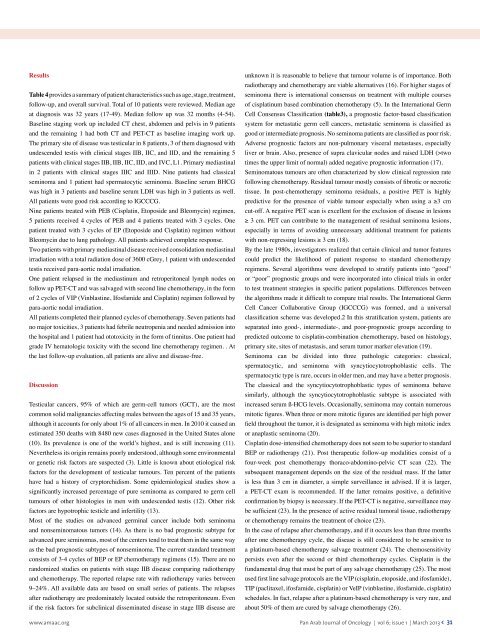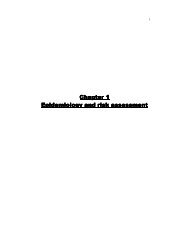Pan Arab Journal of Oncology - Arab Medical Association Against ...
Pan Arab Journal of Oncology - Arab Medical Association Against ...
Pan Arab Journal of Oncology - Arab Medical Association Against ...
Create successful ePaper yourself
Turn your PDF publications into a flip-book with our unique Google optimized e-Paper software.
ResultsTable 4 provides a summary <strong>of</strong> patient characteristics such as age, stage, treatment,follow-up, and overall survival. Total <strong>of</strong> 10 patients were reviewed. Median ageat diagnosis was 32 years (17-49). Median follow up was 32 months (4-54).Baseline staging work up included CT chest, abdomen and pelvis in 9 patientsand the remaining 1 had both CT and PET-CT as baseline imaging work up.The primary site <strong>of</strong> disease was testicular in 8 patients, 3 <strong>of</strong> them diagnosed withundescended testis with clinical stages IIB, IIC, and IID, and the remaining 5patients with clinical stages IIB, IIB, IIC, IID, and IVC, L1. Primary mediastinalin 2 patients with clinical stages IIIC and IIID. Nine patients had classicalseminoma and 1 patient had spermatocytic seminoma. Baseline serum BHCGwas high in 3 patients and baseline serum LDH was high in 3 patients as well.All patients were good risk according to IGCCCG.Nine patients treated with PEB (Cisplatin, Etoposide and Bleomycin) regimen,5 patients received 4 cycles <strong>of</strong> PEB and 4 patients treated with 3 cycles. Onepatient treated with 3 cycles <strong>of</strong> EP (Etoposide and Cisplatin) regimen withoutBleomycin due to lung pathology. All patients achieved complete response.Two patients with primary mediastinal disease received consolidation mediastinalirradiation with a total radiation dose <strong>of</strong> 3600 cGrey, 1 patient with undescendedtestis received para-aortic nodal irradiation.One patient relapsed in the mediastinum and retroperitoneal lymph nodes onfollow up PET-CT and was salvaged with second line chemotherapy, in the form<strong>of</strong> 2 cycles <strong>of</strong> VIP (Vinblastine, Ifosfamide and Cisplatin) regimen followed bypara-aortic nodal irradiation.All patients completed their planned cycles <strong>of</strong> chemotherapy. Seven patients hadno major toxicities, 3 patients had febrile neutropenia and needed admission intothe hospital and 1 patient had ototoxicity in the form <strong>of</strong> tinnitus. One patient hadgrade IV hematologic toxicity with the second line chemotherapy regimen. . Atthe last follow-up evaluation, all patients are alive and disease-free.DiscussionTesticular cancers, 95% <strong>of</strong> which are germ-cell tumors (GCT), are the mostcommon solid malignancies affecting males between the ages <strong>of</strong> 15 and 35 years,although it accounts for only about 1% <strong>of</strong> all cancers in men. In 2010 it caused anestimated 350 deaths with 8480 new cases diagnosed in the United States alone(10). Its prevalence is one <strong>of</strong> the world’s highest, and is still increasing (11).Nevertheless its origin remains poorly understood, although some environmentalor genetic risk factors are suspected (3). Little is known about etiological riskfactors for the development <strong>of</strong> testicular tumours. Ten percent <strong>of</strong> the patientshave had a history <strong>of</strong> cryptorchidism. Some epidemiological studies show asignificantly increased percentage <strong>of</strong> pure seminoma as compared to germ celltumours <strong>of</strong> other histologies in men with undescended testis (12). Other riskfactors are hypotrophic testicle and infertility (13).Most <strong>of</strong> the studies on advanced germinal cancer include both seminomaand nonseminomatous tumors (14). As there is no bad prognostic subtype foradvanced pure seminomas, most <strong>of</strong> the centers tend to treat them in the same wayas the bad prognostic subtypes <strong>of</strong> nonseminoma. The current standard treatmentconsists <strong>of</strong> 3-4 cycles <strong>of</strong> BEP or EP chemotherapy regimens (15). There are norandomized studies on patients with stage IIB disease comparing radiotherapyand chemotherapy. The reported relapse rate with radiotherapy varies between9–24%. All available data are based on small series <strong>of</strong> patients. The relapsesafter radiotherapy are predominately located outside the retroperitoneum. Evenif the risk factors for subclinical disseminated disease in stage IIB disease areunknown it is reasonable to believe that tumour volume is <strong>of</strong> importance. Bothradiotherapy and chemotherapy are viable alternatives (16). For higher stages <strong>of</strong>seminoma there is international consensus on treatment with multiple courses<strong>of</strong> cisplatinum based combination chemotherapy (5). In the International GermCell Consensus Classification (table3), a prognostic factor-based classificationsystem for metastatic germ cell cancers, metastatic seminoma is classified asgood or intermediate prognosis. No seminoma patients are classified as poor risk.Adverse prognostic factors are non-pulmonary visceral metastases, especiallyliver or brain. Also, presence <strong>of</strong> supra clavicular nodes and raised LDH (>twotimes the upper limit <strong>of</strong> normal) added negative prognostic information (17).Seminomatous tumours are <strong>of</strong>ten characterized by slow clinical regression ratefollowing chemotherapy. Residual tumour mostly consists <strong>of</strong> fibrotic or necrotictissue. In post-chemotherapy seminoma residuals, a positive PET is highlypredictive for the presence <strong>of</strong> viable tumour especially when using a ≥3 cmcut-<strong>of</strong>f. A negative PET scan is excellent for the exclusion <strong>of</strong> disease in lesions≥ 3 cm. PET can contribute to the management <strong>of</strong> residual seminoma lesions,especially in terms <strong>of</strong> avoiding unnecessary additional treatment for patientswith non-regressing lesions ≥ 3 cm (18).By the late 1980s, investigators realized that certain clinical and tumor featurescould predict the likelihood <strong>of</strong> patient response to standard chemotherapyregimens. Several algorithms were developed to stratify patients into “good”or “poor” prognostic groups and were incorporated into clinical trials in orderto test treatment strategies in specific patient populations. Differences betweenthe algorithms made it difficult to compare trial results. The International GermCell Cancer Collaborative Group (IGCCCG) was formed, and a universalclassification scheme was developed.2 In this stratification system, patients areseparated into good-, intermediate-, and poor-prognostic groups according topredicted outcome to cisplatin-combination chemotherapy, based on histology,primary site, sites <strong>of</strong> metastasis, and serum tumor marker elevation (19).Seminoma can be divided into three pathologic categories: classical,spermatocytic, and seminoma with syncytiocytotrophoblastic cells. Thespermatocytic type is rare, occurs in older men, and may have a better prognosis.The classical and the syncytiocytotrophoblastic types <strong>of</strong> seminoma behavesimilarly, although the syncytiocytotrophoblastic subtype is associated withincreased serum ß-HCG levels. Occasionally, seminoma may contain numerousmitotic figures. When three or more mitotic figures are identified per high powerfield throughout the tumor, it is designated as seminoma with high mitotic indexor anaplastic seminoma (20).Cisplatin dose-intensified chemotherapy does not seem to be superior to standardBEP or radiotherapy (21). Post therapeutic follow-up modalities consist <strong>of</strong> afour-week post chemotherapy thoraco-abdomino-pelvic CT scan (22). Thesubsequent management depends on the size <strong>of</strong> the residual mass. If the latteris less than 3 cm in diameter, a simple surveillance in advised. If it is larger,a PET-CT exam is recommended. If the latter remains positive, a definitiveconfirmation by biopsy is necessary. If the PET-CT is negative, surveillance maybe sufficient (23). In the presence <strong>of</strong> active residual tumoral tissue, radiotherapyor chemotherapy remains the treatment <strong>of</strong> choice (23).In the case <strong>of</strong> relapse after chemotherapy, and if it occurs less than three monthsafter one chemotherapy cycle, the disease is still considered to be sensitive toa platinum-based chemotherapy salvage treatment (24). The chemosensitivitypersists even after the second or third chemotherapy cycles. Cisplatin is thefundamental drug that must be part <strong>of</strong> any salvage chemotherapy (25). The mostused first line salvage protocols are the VIP (cisplatin, etoposide, and ifosfamide),TIP (paclitaxel, ifosfamide, cisplatin) or VeIP (vinblastine, ifosfamide, cisplatin)schedules. In fact, relapse after a platinum-based chemotherapy is very rare, andabout 50% <strong>of</strong> them are cured by salvage chemotherapy (26).www.amaac.org <strong>Pan</strong> <strong>Arab</strong> <strong>Journal</strong> <strong>of</strong> <strong>Oncology</strong> | vol 6; issue 1 | March 2013 < 31









